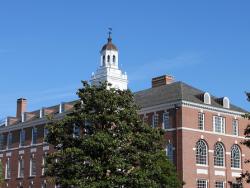Gilman Hall, built in 1916-1917, accommodated a growing College of Chemistry by providing expanded research and teaching facilities for faculty and students specializing in physical, inorganic and nuclear chemistry. Work performed at Gilman Hall helped advance the fields of chemical thermodynamics and molecular structure, and has resulted in multiple Nobel Prizes. The Hall is most famous for the work of Glenn T. Seaborg and his coworkers, which included the successful identification and production the element Plutonium. Seaborg received the Nobel Prize in 1951 for his accomplishments.
Lewis, Gilbert

YearAdded:
Image Credit:
Courtesy Flickr/Waqas Bhatti (CC BY-SA 2.0)
Image Caption:
Gilman Hall
Era_date_from:
1917
1997

Gilman Hall, built in 1916-1917, accommodated a growing College of Chemistry by providing expanded research and teaching facilities for faculty and students specializing in physical, inorganic and nuclear chemistry. Work performed at Gilman Hall helped advance the fields of chemical…
Read More

